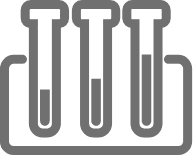Intended for US Healthcare Professionals
Are you ready to share the medical evidence with your quality team?
Quality measures from various organizations, including the National Quality Forum (NQF), the National Committee for Quality Assurance (NCQA), and The Joint Commission (JC), have been established to help improve osteoporosis management.
Electronic health record (EHR) systems can be used to help identify, investigate, and intervene with appropriate patients.1,2 Explore available resources to learn how EHR systems can help automate the systemic identification of patients with osteoporosis-related fractures to help improve patient care.
Experts acknowledge that there is a decrease in the diagnosis and treatment of osteoporosis, even in patients who have suffered a fracture.3 A central DXA (dual-energy X-ray absorptiometry) scan can be used to diagnose osteoporosis before a broken bone occurs.4
Technologies may enhance patient identification initiatives by leveraging opportunistic screenings
CT=computed tomography.
Clinical pathways can help identify appropriate patients at risk for fragility fractures. They address patients in the pathway that have not been identified before treatment and those identified afterwards.9
Example of a bone health pathway for use before hospital discharge:

Hypothetical Scenario9
A patient > 50 years of age presents with a low-trauma fracture.

Lab Tests (Blood Test)9,10
In addition to basic laboratory tests, additional tests (eg, vitamin D level, calcium level, TSH and PTH) are conducted to assess for secondary causes of osteoporosis.

Patient Education9
Before discharge, the patient and their family members are provided education on osteoporosis, allowing a shared involvement in the patient’s bone health. Proper education includes

Primary Care Provider Follow-up9
Primary care providers ensure continuity of care for disease management and further evaluate the disease after the patient is discharged from the hospital. Considerations for follow-up appointments include but are not limited to
Explore the real-world outcomes of organizations of various types, sizes, and locations that have implemented PFC programs.

The FLS model has become incorporated into the methods of care provided at Wake Forest Health System.12 Patients are now captured at various points in the system, including primary care and other specialties as well as self-referrals.12
*For more information on the Wake Forest Health System FLS, please see article here.
In 2009, the American Orthopaedic Association (AOA) launched Own the Bone® as a national quality-improvement program. The program’s goal is to provide tools and techniques for sites to use in real-world practice to enhance secondary fracture prevention.
From 2009 to 2016, the AOA conducted an investigation of the program to determine the percentage of patients in the program for whom anti-osteoporosis treatment was recommended or started at the time of initial evaluation. It also studied the association between the recommendation for osteoporosis treatment and a variety of patient and fracture variables.
The strongest associations between patient factors and likelihood of anti-osteoporosis treatment being recommended were:
 Sedentary lifestyle (no ambulation or activity outside the home)
Sedentary lifestyle (no ambulation or activity outside the home)  Parental history of hip fracture
Parental history of hip fracture  Prior fragility fracture
Prior fragility fracture  Parental history of hip fracture
Parental history of hip fracture  Female sex
Female sex  Vitamin D deficiency
Vitamin D deficiency 
The FLS model has become incorporated into the methods of care provided at Wake Forest Health System.12 Patients are now captured at various points in the system, including primary care and other specialties as well as self-referrals.12
*For more information on the Wake Forest Health System FLS, please see article here.

In 2009, the American Orthopaedic Association (AOA) launched Own the Bone® as a national quality-improvement program. The program’s goal is to provide tools and techniques for sites to use in real-world practice to enhance secondary fracture prevention.
From 2009 to 2016, the AOA conducted an investigation of the program to determine the percentage of patients in the program for whom anti-osteoporosis treatment was recommended or started at the time of initial evaluation. It also studied the association between the recommendation for osteoporosis treatment and a variety of patient and fracture variables.
The strongest associations between patient factors and likelihood of anti-osteoporosis treatment being recommended were:
 Sedentary lifestyle (no ambulation or activity outside the home)
Sedentary lifestyle (no ambulation or activity outside the home)  Parental history of hip fracture
Parental history of hip fracture The strongest associations between patient factors and the likelihood of anti-osteoporosis treatment being initiated were:
 Prior fragility fracture
Prior fragility fracture  Female sex
Female sex  Parental history of hip fracture
Parental history of hip fracture  Vitamin D deficiency
Vitamin D deficiency Own the Bone® is a trademark of the American Orthopaedic Association.
References: 1. Miller AN, Lake AF, Emory CL. Establishing a fracture liaison service: an orthopaedic approach. J Bone Joint Surg Am. 2015;97:675-681. 2. Feldstein A, Elmer PJ, Smith DH, et al. Electronic medical record reminder improves osteoporosis management after a fracture: a randomized controlled trial. J Am Geriatr Soc. 2006;54:450-457. 3. Hansen D, Pelizzari P, Pyenson B. Medicare cost of osteoporotic fractures. Accessed February 15, 2022. https://us.milliman.com/-/media/Milliman/importedfiles/ektron/medicare_cost_of_osteoporotic_fractures.ashx. 4. Bone Health & Osteoporosis Foundation website. Bone density exam/testing. Accessed February 15, 2022. https://www.bonehealthandosteoporosis.org/patients/diagnosis-information/bone-density-examtesting/. 5. Akesson K, Marsh D, Mitchell PJ. Capture the Fracture: a Best Practice Framework and global campaign to break the fragility fracture cycle. Osteoporos Int. 2013;24:2135-2152. 6. ON Diagnostics. Fracture Risk Assessment. Accessed February 15, 2022. https://ondiagnostics.com/. 7. Lenchik L, Weaver AA, Ward RJ, Boone JM, Boutin RD. Opportunistic screening for osteoporosis using computed tomography: state of the art and argument for paradigm shift. Curr Rheumatol Rep. 2018;20:74. 8. Valentinitsch A, Trebeschi S, Kaesmacher J, et al. Osteoporos Int. 2019;30:1275-1285. 9. Wool NK, Wilson S, Chong ACM, Dart BR. Bone health improvement protocol. Kansas Journal of Medicine. 2017;10:62-66. 10. Camacho PM, Petak S, Binkley N, et al. American Association of Clinical Endocrinologists/American College of Endocrinology Clinical Practice Guidelines for the Diagnosis and Treatment of Postmenopausal Osteoporosis-2020 Update. Endocr Pract. 2020;26(suppl 1):1-46. 11. Scholten DJ, Bray JK, Wang KY, Lake AF, Emory CL. Implementation of a fracture liaison service and its effects on osteoporosis treatment adherence and secondary fracture at a tertiary care academic health system. Arch Osteoporos. 2020;15:80. https://doi.org/10.1007/s11657-020-00736-1. 12. Own the Bone. Success Stories. Accessed February 15, 2022. https://www.ownthebone.org/why-otb/success-stories/#1605891404128-4ecb5b94-2d61. 13. Capture the Fracture. What is a post fracture care coordination program (PFC)? Accessed February 15, 2022. https://www.capturethefracture.org/what-is-a-pfc. 14. Dirschl DR, Rustom H. Practice patterns and performance in U.S. fracture liaison programs. J Bone Joint Surg Am. 2018;100:680-685.